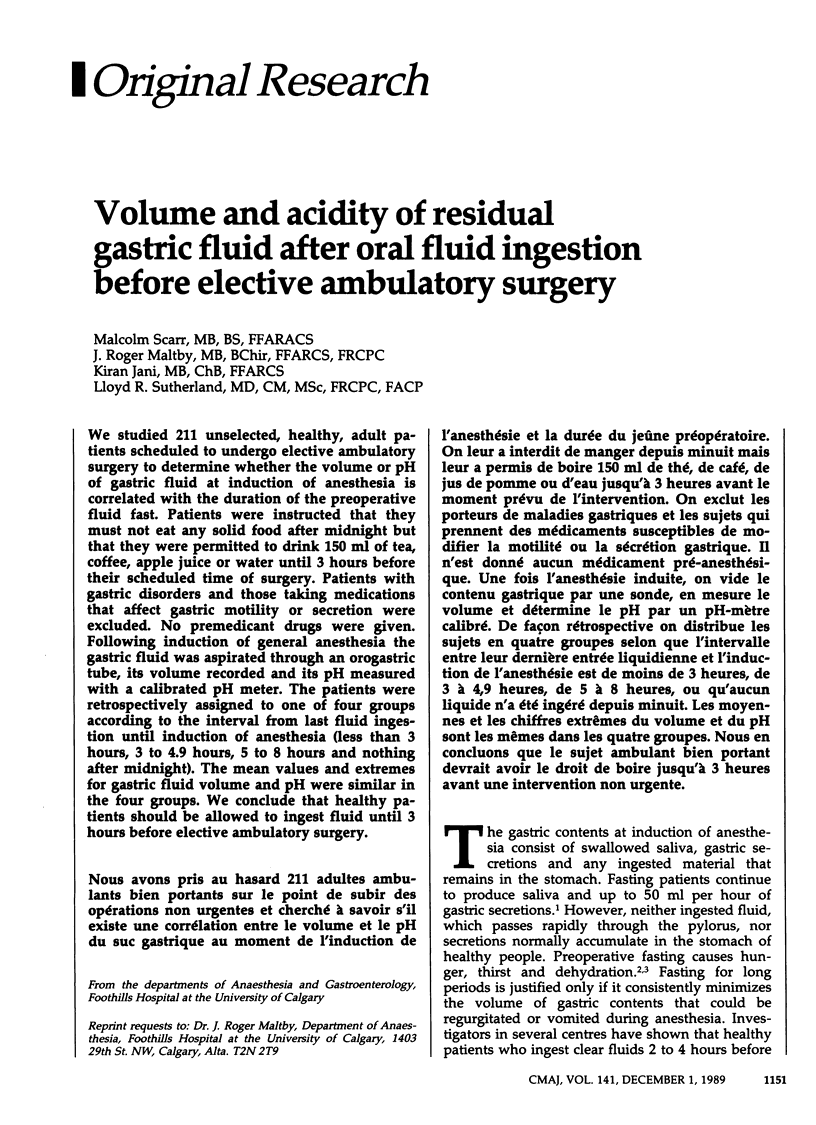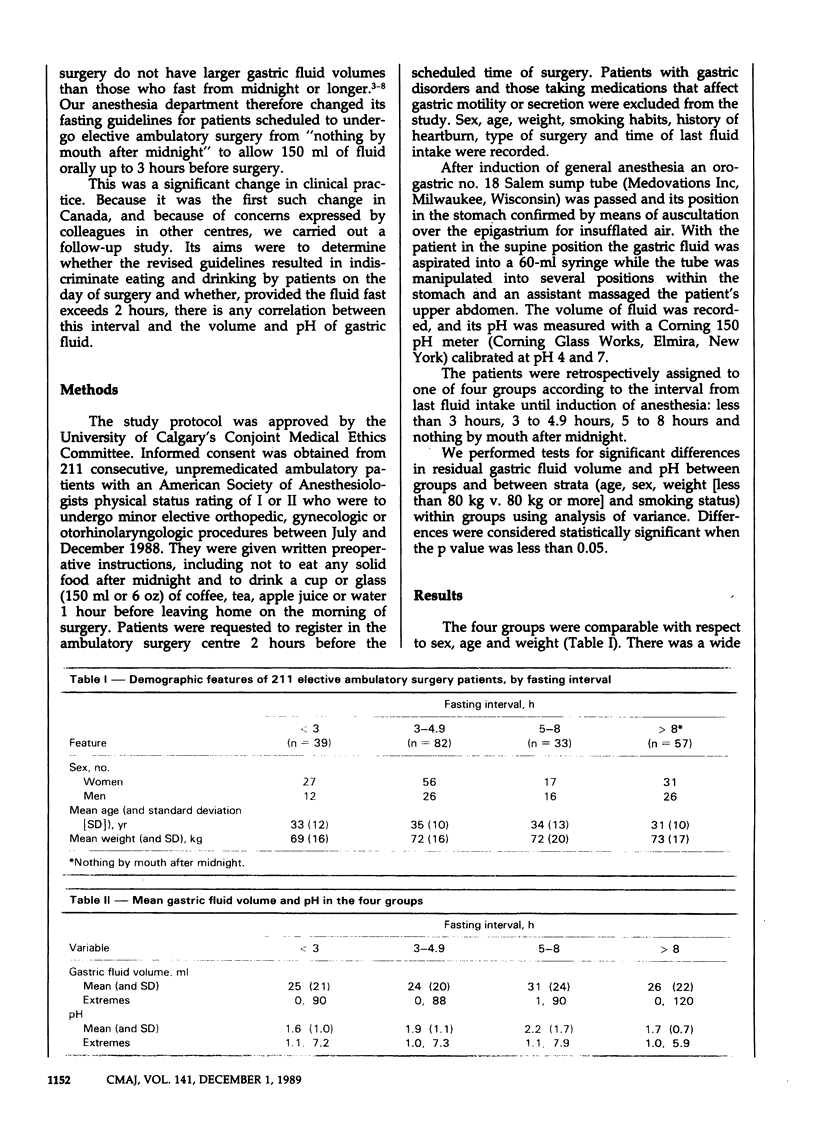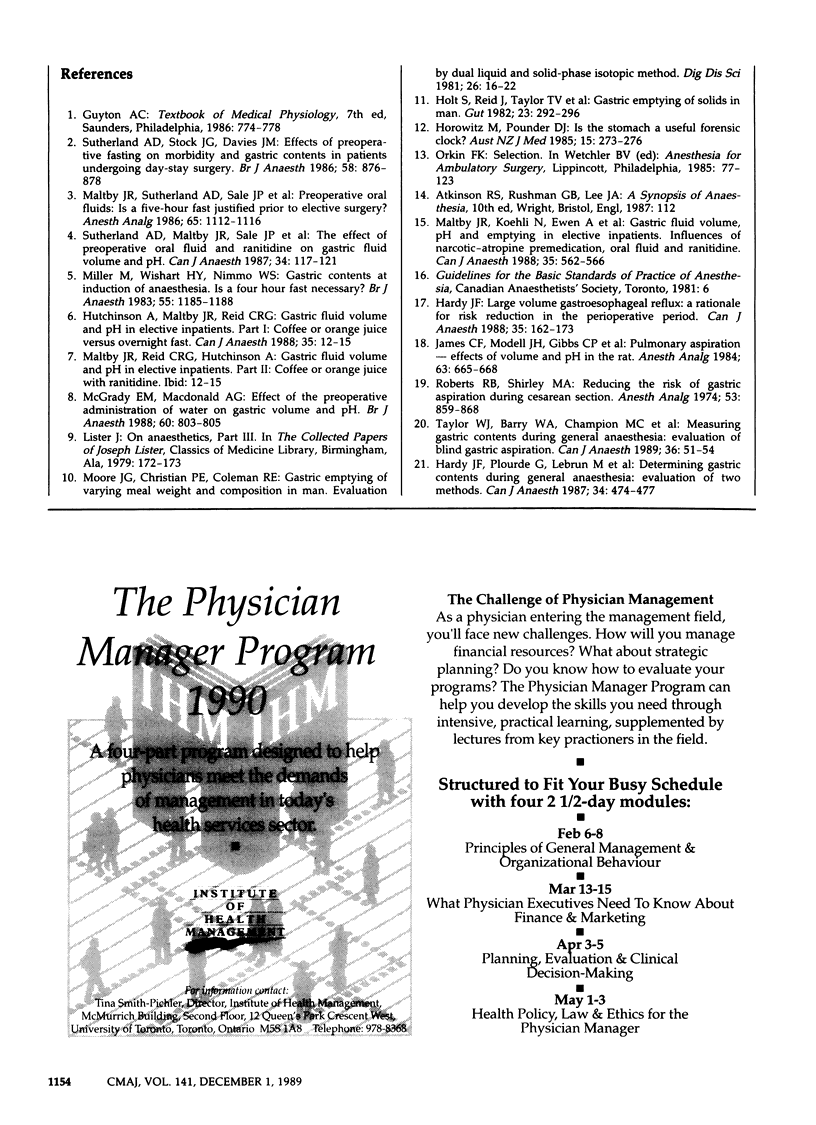Abstract
We studied 211 unselected, healthy, adult patients scheduled to undergo elective ambulatory surgery to determine whether the volume or pH of gastric fluid at induction of anesthesia is correlated with the duration of the preoperative fluid fast. Patients were instructed that they must not eat any solid food after midnight but that they were permitted to drink 150 ml of tea, coffee, apple juice or water until 3 hours before their scheduled time of surgery. Patients with gastric disorders and those taking medications that affect gastric motility or secretion were excluded. No premedicant drugs were given. Following induction of general anesthesia the gastric fluid was aspirated through an orogastric tube, its volume recorded and its pH measured with a calibrated pH meter. The patients were retrospectively assigned to one of four groups according to the interval from last fluid ingestion until induction of anesthesia (less than 3 hours, 3 to 4.9 hours, 5 to 8 hours and nothing after midnight). The mean values and extremes for gastric fluid volume and pH were similar in the four groups. We conclude that healthy patients should be allowed to ingest fluid until 3 hours before elective ambulatory surgery.
Full text
PDF



Selected References
These references are in PubMed. This may not be the complete list of references from this article.
- Hardy J. F. Large volume gastroesophageal reflux: a rationale for risk reduction in the perioperative period. Can J Anaesth. 1988 Mar;35(2):162–173. doi: 10.1007/BF03010658. [DOI] [PubMed] [Google Scholar]
- Hardy J. F., Plourde G., Lebrun M., Côté C., Dubé S., Lepage Y. Determining gastric contents during general anaesthesia: evaluation of two methods. Can J Anaesth. 1987 Sep;34(5):474–477. doi: 10.1007/BF03014353. [DOI] [PubMed] [Google Scholar]
- Holt S., Reid J., Taylor T. V., Tothill P., Heading R. C. Gastric emptying of solids in man. Gut. 1982 Apr;23(4):292–296. doi: 10.1136/gut.23.4.292. [DOI] [PMC free article] [PubMed] [Google Scholar]
- Horowitz M., Pounder D. J. Is the stomach a useful forensic clock? Aust N Z J Med. 1985 Apr;15(2):273–276. doi: 10.1111/j.1445-5994.1985.tb04034.x. [DOI] [PubMed] [Google Scholar]
- Hutchinson A., Maltby J. R., Reid C. R. Gastric fluid volume and pH in elective inpatients. Part I: Coffee or orange juice versus overnight fast. Can J Anaesth. 1988 Jan;35(1):12–15. doi: 10.1007/BF03010537. [DOI] [PubMed] [Google Scholar]
- James C. F., Modell J. H., Gibbs C. P., Kuck E. J., Ruiz B. C. Pulmonary aspiration--effects of volume and pH in the rat. Anesth Analg. 1984 Jul;63(7):665–668. [PubMed] [Google Scholar]
- Maltby J. R., Koehli N., Ewen A., Shaffer E. A. Gastric fluid volume, pH, and emptying in elective inpatients. Influences of narcotic-atropine premedication, oral fluid, and ranitidine. Can J Anaesth. 1988 Nov;35(6):562–566. doi: 10.1007/BF03020340. [DOI] [PubMed] [Google Scholar]
- Maltby J. R., Sutherland A. D., Sale J. P., Shaffer E. A. Preoperative oral fluids: is a five-hour fast justified prior to elective surgery? Anesth Analg. 1986 Nov;65(11):1112–1116. [PubMed] [Google Scholar]
- McGrady E. M., Macdonald A. G. Effect of the preoperative administration of water on gastric volume and pH. Br J Anaesth. 1988 Jun;60(7):803–805. doi: 10.1093/bja/60.7.803. [DOI] [PubMed] [Google Scholar]
- Miller M., Wishart H. Y., Nimmo W. S. Gastric contents at induction of anaesthesia. Is a 4-hour fast necessary? Br J Anaesth. 1983 Dec;55(12):1185–1188. doi: 10.1093/bja/55.12.1185. [DOI] [PubMed] [Google Scholar]
- Moore J. G., Christian P. E., Coleman R. E. Gastric emptying of varying meal weight and composition in man. Evaluation by dual liquid- and solid-phase isotopic method. Dig Dis Sci. 1981 Jan;26(1):16–22. doi: 10.1007/BF01307971. [DOI] [PubMed] [Google Scholar]
- Roberts R. B., Shirley M. A. Reducing the risk of acid aspiration during cesarean section. Anesth Analg. 1974 Nov-Dec;53(6):859–868. doi: 10.1213/00000539-197453060-00010. [DOI] [PubMed] [Google Scholar]
- Sutherland A. D., Maltby J. R., Sale J. P., Reid C. R. The effect of preoperative oral fluid and ranitidine on gastric fluid volume and pH. Can J Anaesth. 1987 Mar;34(2):117–121. doi: 10.1007/BF03015327. [DOI] [PubMed] [Google Scholar]
- Sutherland A. D., Stock J. G., Davies J. M. Effects of preoperative fasting on morbidity and gastric contents in patients undergoing day-stay surgery. Br J Anaesth. 1986 Aug;58(8):876–878. doi: 10.1093/bja/58.8.876. [DOI] [PubMed] [Google Scholar]
- Taylor W. J., Champion M. C., Barry A. W., Hurtig J. B. Measuring gastric contents during general anaesthesia: evaluation of blind gastric aspiration. Can J Anaesth. 1989 Jan;36(1):51–54. doi: 10.1007/BF03010887. [DOI] [PubMed] [Google Scholar]


